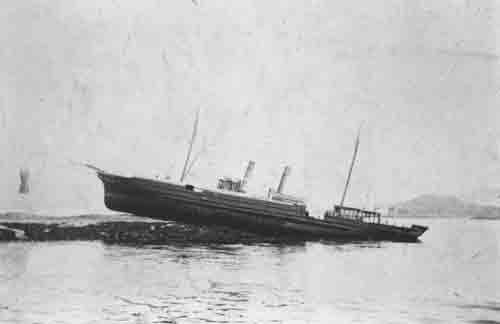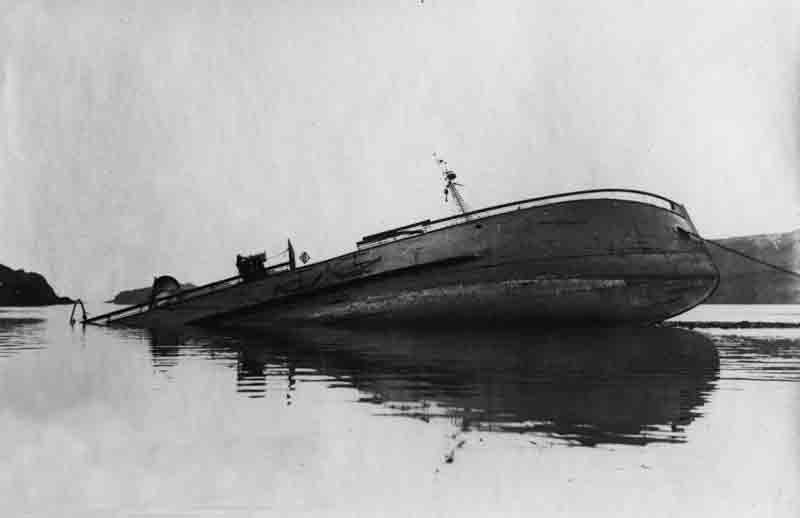The small iron cargo passenger steamship Kintyre is generally acknowledged to have been one of the most graceful steamers of her type to sail on the Clyde. Owned by Campbeltown & Glasgow Steam Packet Joint Stock Company, she was familiarly referred to as the Campbeltown Yacht, because of her raked lines and clipper bow. Built by Robertson & Company, Greenock (Yard No 10) she was launched on 10th June 1868. She measured 184.7′ x 22.9′ x 11.5′ and her tonnage was 314 gross tons, 94 net tons. She was powered by a compound steam engine by Kincaid, Donald and Co Ltd of Greenock delivering 90 registered horse power.
On Wednesday 18th September, 1907 the Kintyre was lost in collision with the 3500 gross ton steamer Maori about four hundred yards south west of Wemyss Point. The Maori, only recently completed by her builders Denny of Dumbarton, was undergoing speed trials on the measured mile at Skelmorlie. On completing a run northwards, she passed Wemyss Bay Pier and altered course to port before swinging in a wide arc back into Wemyss Bay for her next run south. Meanwhile the Kintyre, en route to Tarbert via Campbeltown, was steering a course close to the Renfrewshire coast. When the vessels were about half a mile apart signals were exchanged, the Maori making it clear she was continuing her long turn to starboard. At this point the Kintyre should have slowed to let the larger vessel pass in front but, either due to some misunderstanding or more likely a desire not to waste time by slowing, no order to that effect was given by her master, Captain MacKechnie. Steaming at full speed the Kintyre cut across the path of the Maori which, by now, was very close. The engines of the Maori were put full astern but her momentum could not be checked before she crashed into the starboard side of the Kintyre near the aft hatch. The two vessels remained locked together long enough for most of the crew of the Kintyre to clamber aboard the Maori. Meanwhile the Kintyre was beginning to sink and, with water quickly filling the engine room and aft cabin, her stern soon became submerged.
Captain MacKechnie and William Lennox, her engineer, remained on the bridge of the Kintyre and made a brave attempt to beach her. However, four minutes after the collision, a hissing sound came from the engine room, followed by a muffled explosion and then, in twenty seconds, the Kintyre slipped beneath the surface. As the Kintyre sank the two men still aboard were thrown into the sea. Captain MacKechnie had a miraculous escape. Dragged down by a piece of wreckage tangled around his legs, he managed to free himself and floated to the surface, where he was picked up by a small boat. Suffering from exhaustion, he was taken to the Wemyss Bay Hotel where he was treated by a doctor. William Lennox was less fortunate and could not be found after an extensive search.
In December 1907 the owners of the Kintyre took William Denny & Bros to court, trying to recover £10,000 damages for the loss of their vessel. Lord Salvesen presiding held that the collision was caused solely by the actions of those aboard the Kintyre and her owners had to shoulder the burden of an uninsured loss.
The Kintyre can be located approximately 400 metres south south west of Wemyss Point and some 200 metres off shore in position 55°53.178’N, 004°53.974’W. Lying on an even keel on a steeply sloping seabed, she is oriented 90°/270° with her bow pointing towards the shore.
The Kintyre is somewhat deeper than most of the diveable wrecks in the area, the depths around the wreck ranging from 38 to 49 metres bow to stern. Rising on average 3 metres from the seabed, the hull is reasonably intact except for an area on her starboard side aft of the engine room running aft to the stern which has collapsed onto the seabed.
Apart from the depth, the wreck itself provides few problems for the diver. Hold and accommodation areas either side of the engine room centre section are open and easily accessible. The remains of deck beams, winches and other wreckage can be found protruding from the deep silt. The clipper bow, the most visually dramatic part of the wreck, rears some 4 metres out of the seabed. The plating around this area has fallen away to expose the cage like structural members of her hull which are now covered in orange and white plumose anemone.
It is possible to dive this wreck from the beach by following the sewer outfall pipe from the concrete structure inshore of the wreck. On reaching 42 metres head north along the slope, the wreck lies some 10 – 15 metres north of the pipe. However, due to the depth of the wreck and the distance from the shore the authors would strongly advise against this method of diving the wreck.




















































